‘Back to the Future’ writer on how movie became a musical — and how it very nearly didn’t
When people ask Bob Gale why he thinks “Back to the Future” has endured for as long as it has — why audiences continue to revere and appreciate the franchise he co-created and co-wrote after nearly four decades — he gives a rather unexpected answer.
It’s not Michael J. Fox’s Marty McFly or Christopher Lloyd’s Doc Brown. It’s not the DeLorean.
Nor is it that Gale helped breathe new life into Marty, Doc and their flying car by re-teaming with “Back to the Future” movie director Robert Zemeckis to turn the story into a stage musical that will land in Charlotte this month.
Rather, says the 73-year-old scribe, it’s this: “When we wrote the movie, we knew it was a really great story, and we thought it was really cool, the idea that you could end up going to high school with your parents. Because every kid, at some point, comes to the realization — ‘Oh my God, my parents were once awkward teenage screw-ups like me. What was that like? How did they go on their first date? What happened? Where did they do it? How did I get here?’
“I mean, some of those things you don’t want to think about too much, maybe,” Gale adds, chuckling. “But it’s really an extremely powerful part of our humanity.”
As for how well it works with singing and dancing? Well enough that “Back to the Future: The Musical” has gone from debuting in England in 2020 to opening on Broadway last year to a U.S. tour being performed at Belk Theater July 9-21.
Well enough that The Hollywood Reporter’s August 2023 review marveled, “What is surprising is how effective and damn fun it all is.” And well enough to overlook the fact that there was a time when Gale and Zemeckis worried that their musical might not have a future.
Gale spoke to The Charlotte Observer recently about the concept’s initial failure to launch, why it’s easier to replace Michael J. Fox on stage than onscreen, and how the musical’s production team figured out how to create “an illusion that really has to kill.”
The conversation has been lightly edited for clarity and brevity.
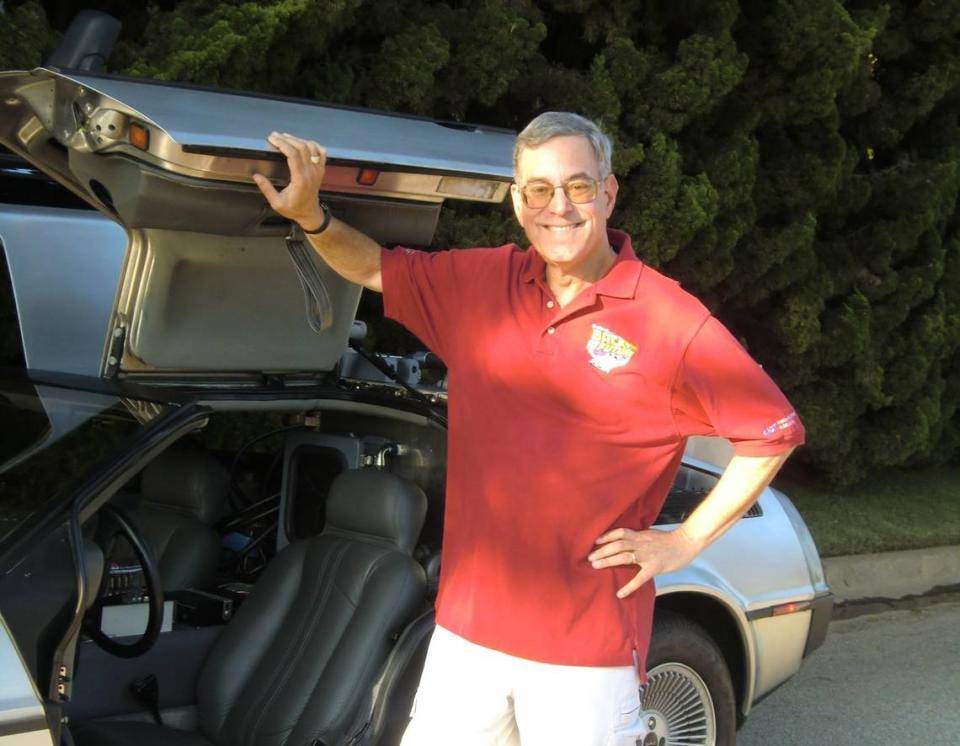
Q. When I first heard about the movie being made into a musical, I was really skeptical. I’m 50. I was not quite 13 when it came out. So “Back to the Future” has meant a lot to me for a long time.
Sure, I understand that. You’re not the first person to tell me that “I was really skeptical.” So I get it, and you had good reason to be skeptical.
Q. I imagine that was a daunting challenge, just because of the pressure that I would think comes with trying to reinterpret something so beloved and so etched into people’s minds. But maybe it was more exciting for you than daunting?
It was all the above. And the secret weapon Bob Zemeckis and I had was that, first of all, nobody was beating down our doors saying, “You guys gotta make this into a musical.” That was not happening. So we knew that if there never was a “Back to the Future” musical, nobody would care. Nobody would lose any sleep over that.
And we had something called separated rights, which the Writers Guild gives you if you’ve written an original screenplay. That means the theater rights belong to the original writers. So we knew that if this wasn’t coming out in a way worthy of it being called “Back to the Future,” we would just push the red button and eject, and that would be the end of it. Knowing you can walk away always gives you a lot of extra strength.
Q. Were there times during the process where you had your finger anywhere close to the red button?
Yeah, there were. We started working on this in earnest in February 2006. So, just to put this into perspective for you, the idea for “Back to the Future” came to me in August 1980. Ten years later, in August 1990, we’d already made all three movies. Now, we decided to start working on the musical in February 2006. Ten years later, in February 2016, we were nowhere. We were nowhere!
We’d hired a director (in early 2014), and we thought, okay, he will help us shape the material. Because we didn’t have any musical-theater experience ourselves at the time. This guy had some interesting things to say. We didn’t quite understand some of what he was trying to get across. But we said, “Alright, let’s take a flyer on this guy.” And it didn’t work out. It really was creative differences. And there was a period there after we fired him (in late summer 2014) when we just thought, Are we ever gonna get this thing off the ground? Maybe it’s not meant to be.
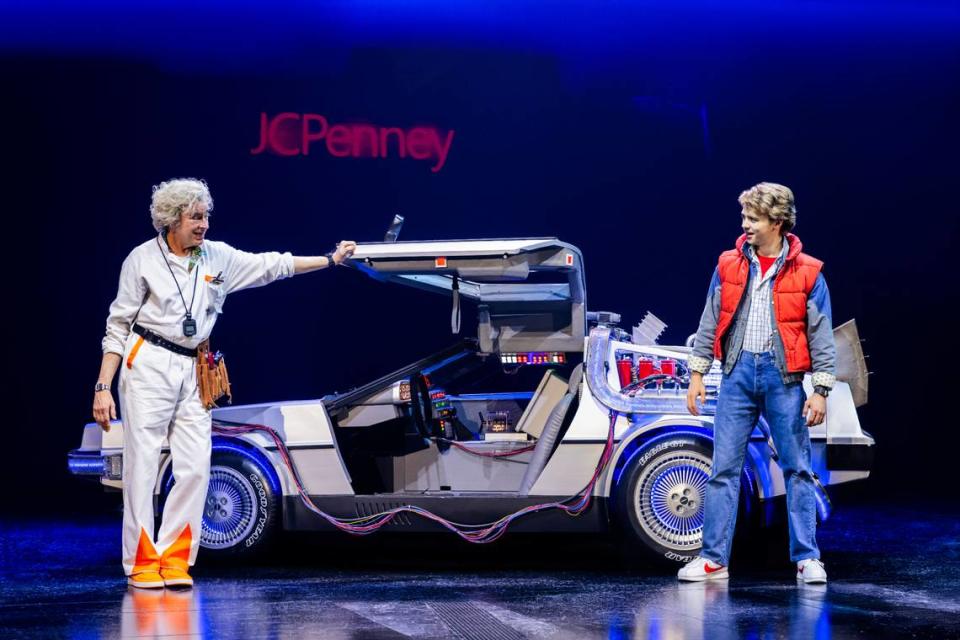
Thankfully, we had the vision of songwriter Glen Ballard on our side. Glen said, “Look, we’ve written all these songs. But nobody’s ever heard these songs except us. So —” as Mickey Rooney would say “— let’s put on a show. Let’s do a showcase, and invite a whole bunch of people, including ‘Back to the Future’ fans. Let’s present these songs in a really slick, professional way.”
People heard these songs, and they said, “Wow! This really is capturing the spirit of ‘Back to the Future.’ You guys should keep going!” So yeah, that’s the craziness of the creative process.

Q. So when you fired that director, did you just blow up the work that had been done on the project to that point and then start from scratch with the new director? Or...?
When we decided to put on this showcase, part of our thinking process was, Okay, we were depending on this guy from the outside to help us figure out what ‘Back to the Future’ was going to be. But we looked at ourselves and we said, “Nobody knows what ‘Back to the Future’ should be better than we do. So we should do it. We need to say, ‘This is the vision we have of Back to the Future.’ Let’s find a director who shares that creative vision with us.”
Ultimately, our producer Colin Ingram found John Rando, and Rando turned out to be the absolute perfect director for us. He brought so much to the party — was like a walking encyclopedia of musical theater. I got a hell of a good education from John. And we never had any serious disagreements about anything. It was really a joyful creative experience.
Q. I don’t want to harp too much on the original director, but I was just curious: When you say “it didn’t work” with him, I would love to know just a little bit more about what that means.
His name is Jamie Lloyd. It’s not a secret. And since then he’s created a new identity for himself doing minimalist versions of shows that have been done on a bigger scale. But, for example, he didn’t think Biff should sing. And I said, “What are you talking about? Biff’s gotta sing. When I talk to people and say, ‘We’re doing a musical,’ they say, ‘I can’t wait to hear Biff sing!’” He said, “No, no, I think that the villain is more formidable if he doesn’t sing.” And I’m going, “Um, have you seen ‘Les Miz’? Have you seen ‘Peter Pan’? Captain Hook has some great numbers.” So, in a nutshell, that was a difference in philosophy. He also did not particularly like the material (music and lyrics) that Alan Silvestri and Glen Ballard were coming up with, which Bob Zemeckis and I just loved. Most of those things are still in the show.
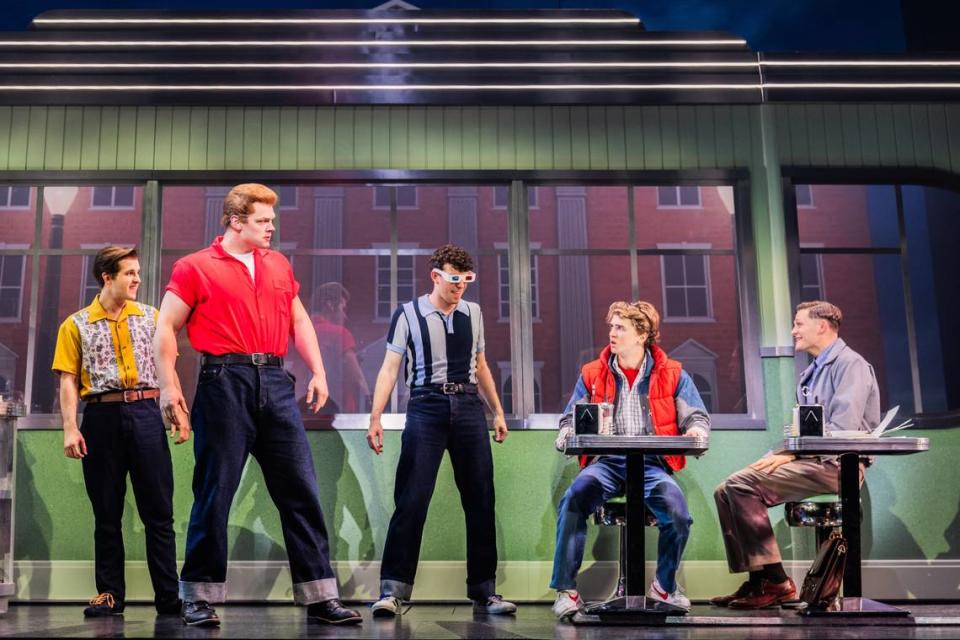
The other interesting thing I did was I went through the movie, and I said, “What are the things we absolutely cannot do on a stage?” And the very first thing was the skateboard chase. The lead actor, he has to act, be funny, sing, dance. You cannot also expect this guy to be able to do championship-style skateboard stunts. Right? We can get around that in the movie; you just get the stunt guy in there to do that stuff. But (for the stage), it was just like, Forget that. Even if he was reasonably okay on a skateboard, you’re risking having the guy break his ankle every show. That’s insane.
Then number two was: You can’t have the terrorist chase on a stage with gunfire. So we got rid of that. And number three was: We don’t need to do the Darth Vader scene. Because it’s ridiculous on stage to have an actor with his face completely covered, where you can’t see his face — as they discovered when they made “Spider Man: The Musical.”
Well, we start working with Jamie Lloyd and he says, “I want to put the Darth Vader scene back in, and I want to do a version of the skateboard chase. And I really think we need to have the terrorists. And I’m going, Oh, f---. Really? We’re not seeing the same thing here. We gave him (a chance). Maybe he’s seeing something here that I don’t see. But, no. No.
Q. It’s funny that you mentioned that, though: what worked in the movie that you can’t do on stage. But I also would have thought — and I haven’t seen the show yet, but — “Well, you can’t make the car fly either.”
Well, yeah, there were certain things where we said, “We’ve gotta do this. We don’t know how we’re gonna do it. But we have to do this.”
Part of it was to say, “Is there a dramatic substitute for Doc being shot by terrorists?” And yeah, there was. Doc is felled by plutonium radiation poisoning. He’s gonna die. Marty had to have a reason to be in a hurry to get back to that particular moment. So that all worked just perfectly, dramatically. It was just, We use radiation instead of an Uzi.
At the same time, we said, “There has to be a DeLorean, it has to go 88 miles an hour, we have to figure out how to create that illusion. We have to do the clock tower scene. We have to have lightning strike the clock tower. These are touchstones of the material, and people are gonna throw eggs at the stage if they don’t see that stuff.”
Well, so far, no eggs have been thrown.

Q. The other thing it would seem that you would have to have is a perfect Marty. I know you’ve talked about why you never rebooted or remade “Back to the Future” movie-wise: because, as you’ve said, you can’t replace Michael J. Fox. But here, on stage, you have to. You had to find the perfect Marty for the original production (Olly Dobson), then you had to find the perfect one for Broadway (Casey Likes), then —
Now we’ve got three of ’em! We’ve got Caden (Brauch), who’s on tour. And they’re all terrific!
Q. But that definitely sounds like a difficult task.
It’s getting easier actually. When we started, the first challenge was that every young actor wanted to star in “Dear Evan Hansen.” And Evan Hanson is 180 degrees from what Marty McFly is, right? So we needed to find the actor who isn’t obsessed with that role, and can be the bull in a china shop that Marty McFly is. Then I think what happens is that other actors, they go see the show and they say, “Oh! I can do that! I understand what the part is. I get it now.”
Q. I guess what I wonder, though, is this: How can it be that in the movie, it could only have been Michael J. Fox, but on stage why do you think it’s OK — or easier, at least — to recast the role?
It’s an excellent question. But it’s because when you go to the theater, you don’t expect to see Michael J. Fox. You don’t expect to see Christopher Lloyd. You know that this is musical theater, and that you’re seeing a different set of performers who have different skill sets. That’s the agreement that you make when you buy your ticket, to say, “I know I’m going to see musical theater. I know the actors are gonna be right on stage in front of me. I know that at certain points in this show, people are just gonna burst out into song for no reason. And that’s okay! That’s why I’m going! I want to see that!”
And sometimes (the actors are) gonna make a mistake. And that’s okay, too! If you ever end up going to see the show on Broadway in the next nine months here — with Casey Likes as Marty and Roger Bart as Doc — I mean, these guys have a chemistry. There are certain moments where they’re just actively trying to break the other guy up. The audience just loves seeing that. It’s really fun.
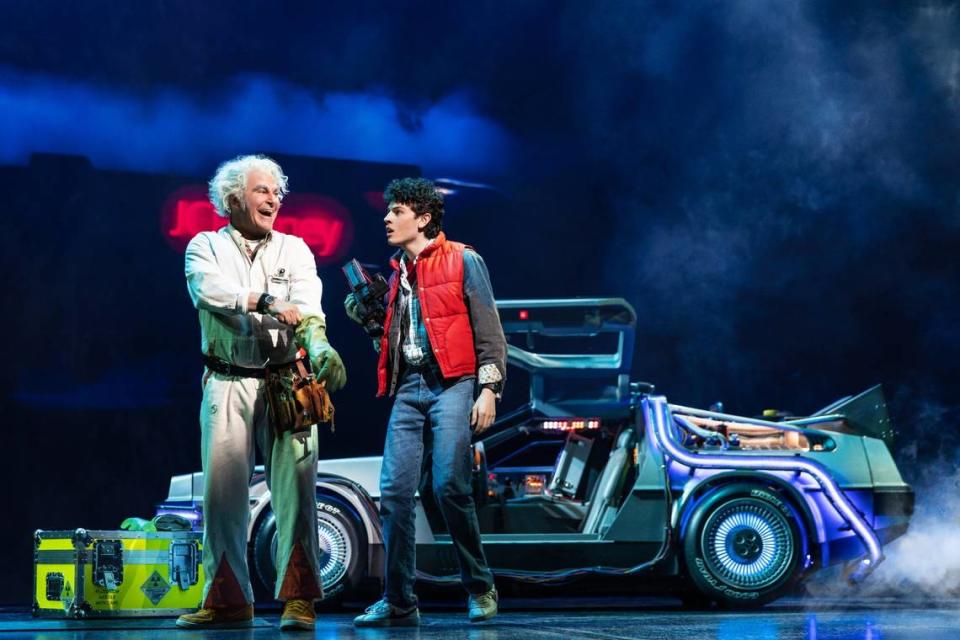
I think Caden Brauch and Don Stephenson (the touring Doc) are developing it, too. The audiences in Charlotte are gonna have the advantage of seeing a show where the actors have been doing these parts for the past four-and-a- half weeks. So they’re gonna be better at it than they were the first week in Cleveland.
I mean, casting — this goes way back to something that George Lucas told us back in the ’70s. He said, “The two most important elements of a movie are the script and the cast. You can buy everything else. But if the cast isn’t doing it right —” which is why we replaced Eric Stoltz (with Michael J. Fox) in the first movie “— it doesn’t matter. Doesn’t matter if you have the best script.”
Q. Speaking of being able to “buy everything else”: The car and the visual effects that power them — how big a team and how much brainpower had to go into making that work?
Yeah, it’s pretty impressive. One of the most gratifying aspects of doing this show was that everybody who signed on for it — especially on the technical side — they signed on to it because they love the movie. They said, “Somebody’s gonna do this, I want it to be me. And I’m not gonna be the guy to screw it up.” Everybody put their egos outside the door and said, “This is an illusion that really has to kill.” And boy, did they figure some cool stuff out.
You have a car that is made out of fiberglass. It’s not a stainless steel DeLorean, because it would be way too heavy. It sits on a turntable that we can move. We can move the car forward, backwards, and 360 degrees. And our video designers and our computer guys, they figured out how to create these moving backdrops and moving foreground things. There’s a front gauze that drops down when the car is about to go anywhere. So you have motion behind the car, you have motion in front of the car, and then the car is doing its own motion, and you marry all these things together, along with some really precise calculations — like, if the car is gonna turn left, then the background has to turn the way you would see if the car was turning left. That all has to be in dead sync.
And here’s a nice little anecdote for you: They were trying to figure out how big the car was gonna be, and we tried three different comparisons. We did full size, but It looks too big on a stage if it’s full-size. 75% was too small. So we ended up halfway in between — which turns out to be 88%.
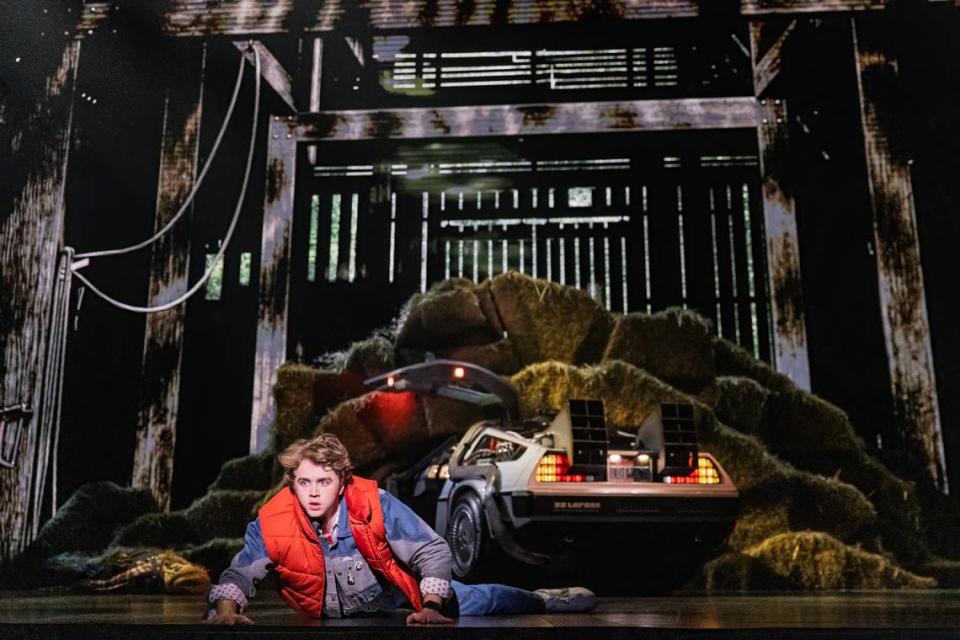
Q. Anything else you want to mention about the show?
I’m gonna leave you with one great anecdote, which is probably my favorite about the show. I was in London checking up on the show towards the end of our first year there, and a woman comes up to me after the show and she says, “Mr. Gale, I just want you to know, I love your show. I love it so much that I come and I see it once a week. And this was my 19th time.”
I said, “Whoa! I’m very flattered, but doesn’t that get expensive?” She said, “Well, I figured it out. You see, I’d been seeing a therapist. And every time I had a therapy session, I felt depressed. But then I went and I saw your show, and I felt great. So I quit seeing my therapist — and that’s the money I use to buy my theater tickets.”
Want to see ‘Back to the Future: The Musical’?
When: Opening night is Tuesday at 7:30 p.m. There are 15 other showtimes through July 21, including matinees on the weekend dates.
Where: Belk Theater at Blumenthal Arts Center, 130 N. Tryon St.
Tickets: Prices start at $46.39 (including taxes and fees) for balcony seats. Premium orchestra seats are $203.17 with taxes and fees.
Details: www.blumenthalarts.org.
More arts coverage
Want to see more stories like this? Sign up here for our free “Inside Charlotte Arts” newsletter: charlotteobserver.com/newsletters. And you can join our Facebook group, “Inside Charlotte Arts,” by going here: facebook.com/groups/insidecharlottearts.


